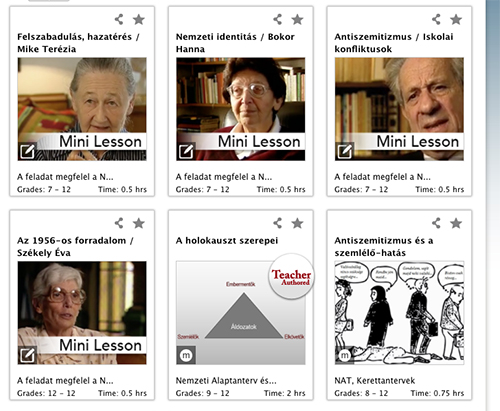Seven New Hungarian-Language Activities Published on IWitness

Last week, USC Shoah Foundation’s education department uploaded a set of new activities to their IWitness activities page, all in Hungarian and part of the Institute’s efforts to globalize the education of students and their teachers about hatred and intolerance using interactive activities, academic resources and video testimonies from USC Shoah Foundation’s Visual History Archive.
The first new activity, called “Antiszemitizmus és a szemlélő-hatás,” focuses on teaching students what it means to be observant and what the possible consequences of being observant could be. To this end, students are tasked with watching and interpreting interviews with the survivors and witnesses of past and present manifestations of anti-Semitism, and with understanding how those witness’ lives were impacted by that treatment. Students will then write messages about what the viewing meant to them.
The next activity, called “A holokauszt szerepei,” is concerned with teaching students about the situations of victims, viewers, perpetrators and human defenders; their choices; and their responsibilities before and during the Holocaust. The variable points of view offered to students will help them gain deeper insight into the genocide events and know how to better respond with active citizenship in cases of injustice that they might see.
The third activity, a mini-lesson called “Az 1956-os forradalom / Székely Éva,” will have students interpret the international background of the 1956 Revolution, and learn how primary sources like video testimony can help develop the skills to evaluate different perspectives.
The next activity, another mini-lesson called “Antiszemitizmus / Iskolai konfliktusok,” will ask students to deal with school conflicts; and the following activity, called “Nemzeti identitás / Bokor Hanna,” will have them interpreting the phenomena of self-definition, identity and national identity.
The final Hungarian-language activity, called “Felszabadulás, hazatérés / Mike Terézia,” will task students with studying post-Holocaust return by watching testimony. The module will prepare students for viewing the Hungarian film 1945, directed by Ferenc Torok.
With the expansion of work done by USC Shoah Foundation in Hungary, the modules could not come at a better time. Although IWitness already carries five Hungarian-language activities, covering topics like the arrival at Auschwitz and the Birkenau Sonderkommando, the Institutes work in Hungary is only just beginning to take off.
Earlier this year, the country integrated and accredited two of the Institute’s programs – ITeach and IWitness – into their national curriculum. As integrated programs of the Education Research and Development Institute (OFI), ITeach and be offered by USC Shoah Foundation staff and its “multipliers,” or educators who have been trained by the Institute, throughout Hungary with the supports of OFI’s network and resources.
The Institute will now be able to reach more educators and students than ever before.